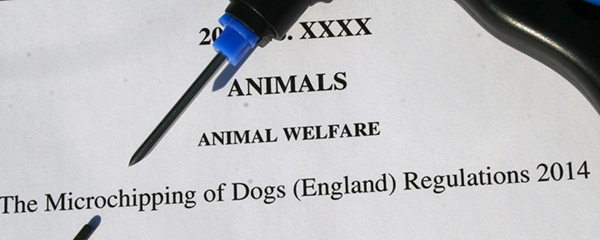Microchipping - The Five Things you absolutely Need to Know

In six months time on April 6th 2016 to be precise, The Microchipping of Dogs (England) Regulations 2015 will require all dogs living and born in England to have been microchipped. However, despite the fact that these regulations will affect millions of dog owners there is still an enormous amount of confusion as to why they have been introduced, who will benefit from them and what the consequences are for non-compliance?
In this article I have identified what I believe to be the five most important points about the compulsory microchipping of dogs and explain how they will affect every dog owner in England.
1. Why Have the Government Introduced Compulsory Microchipping?
On average – according to figures released by DEFRA – 102,000 stray dogs (I think the figure is much higher) are passed into the care of English local authorities every year, resulting in an overall cost to the taxpayer of £9.7m. Of these, over half are reunited with their owners however, after seven days the local authorities are permitted to rehome or destroy every dog whose owner cannot be traced.
DEFRA claims that 27,500 stray dogs – none of which are micro chipped – are rehomed every year but an unfortunate 8,000 strays are not so lucky and are subsequently put to sleep. Which means in a country where we pride ourselves as being animal lovers we are putting to sleep (killing) 22 dogs every day!
The Government has therefore introduced these regulations believing that the greater the traceability of dogs to owners, the more accountable owners become for the welfare and behaviour of their dogs. In addition traceability allows dogs to be quickly re-united with their owners resulting in:
- Dogs spending less time in kennels
- Fewer dogs having to be re-homed
- Fewer dogs being put to sleep
- And an expected saving to local authorities of £3.4m a year
What I don’t like
Most local authorities already charge owners the kennelling fees when they reclaim their dog so the costs and projected savings quoted by DEFRA are misleading. In addition, the implementation costs are going to be extremely high and are likely to wipe out any savings for many years to come.
What I do like
Improving traceability of owners will decrease the number of dogs rehomed or put to sleep. Every puppy born in England after 6th April 2016 must be microchipped by its breeder. The breeder’s details will remain on the database throughout the dog’s life, which means they can be held accountable for poor breeding practices and non-compliance of licensing regulations.
2. What Will Happen if You Don’t Get Your Dog Microchipped?

It is Unlikely You Will Be Prosecuted For Not Getting Your Dog Microchipped
Emm …probably nothing! These regulations will be used primarily to identify owners and breeders of troublesome or unhealthy dogs, who will then be prosecuted under more appropriate legislation. Although local authorities will have the power to prosecute dog owners for non-compliance of the regulations this is unlikely to happen. The Government doesn’t want the already over-burdened justice system dealing with thousands of breaches of microchipping regulations.
However, if you don’t get your dog microchipped then there is a risk that if she goes missing you will never see her again. Right now microchipping is free but only until April 2016. So why wait?
Keep reading to locate the nearest FREE microchipping service to your home.
What I don’t like
I think these regulations are a bit of a toothless tiger and should have included harsh penalties for breeders who fail to microchip puppies. Banning orders for repeat offenders would also have helped to tackle the problem with irresponsible dog owners.
What I do like
Local Authorities will now have the power to microchip all stray dogs that are passed into their care before they are returned to their owners. This will help identify irresponsible dog owners who fail to control their dogs.
3. Does Microchipping Affect Your Dog’s Health?

Microchipping is Unlikely to Affect Your Dogs Health
It is extremely unlikely that your dog will suffer ill health as a result of being microchipped. The microchip is injected under the dog’s skin between its shoulder blades. The needles are supplied in hygienically sealed envelopes and can only be used once. The injection is relatively harmless and the microchip is encased in biocompatible soda lime or borosilicate glass and hermetically sealed. Which means it has been rigorously tested and is airtight, making it incredibly safe for your dog.
On very rare occasions a dog may develop an adverse reaction to a microchip implant but the likelihood of your dog developing a more serious reaction is approximately one in a million. However, it is worth mentioning that a series of veterinary and toxicology studies, dating to the mid – 1990s, stated that microchip implants had ‘induced’ malignant tumours in some lab mice and rats. I suspect that this is why the regulations have introduced a mandatory requirement for all adverse reactions to be reported to the Secretary of State.
There is however a fail-safe because if your Vet believes that your dog may suffer an adverse reaction to being microchipped, then they can issue you with an exemption notice.
If you have a specific concern about your dog’s health then you should contact your local Vet for their advice.
Pet Detective’s Health Warning!
If you don’t get your dog microchipped then there exists a much greater risk to your dog’s health. If he goes missing and is passed to your local authority then after just seven days they are authorised to rehome your dog or worse, put him to sleep.
What I don’t like
It is very difficult to find accurate information about adverse reactions to microchips and this concerns me. I would like a bit more transparency on the subject and feel that information on all adverse reactions should be freely available to all dog owners.
Keep reading to find our link to additional information on adverse reactions.
What I do like
I like the fact that a fail-safe has been introduced. It enables some owners to opt out of compulsory microchipping, especially if their dog is elderly or suffering from ill health.
4. Will Microchipping Your Dog Prevent Her From Being Stolen?
![A Microchip Will Not Prevent the Theft of Your Dog [Photo © The Pet Detectives Ltd]](http://3mxd.com/3eight/production-area/pet-detectives/glass/ckeditor/plugins/imageuploader/uploads/181d145a.jpeg)
A Microchip will not Prevent the Theft of Your Dog [Photo © The Pet Detectives Ltd]
There is no evidence whatsoever that microchipping prevents dog theft. However, it most certainly helps us recover stolen dogs and once the majority of dogs are microchipped in England then it will become extremely difficult for a thief to sell a stolen dog to an unsuspecting buyer. In addition, as of 6th April 2016, when a dog is given or sold to another person, both the existing and the new owner must register the change of details with the respective microchipping company.
A dog thief is unlikely to know the microchip details of the dog they have stolen, which should deter the would-be buyer. Even if the thief knew the microchip number, the moment the new owner attempts to register the dog in their name it will show up on the database as missing or stolen.
Unfortunately, as detailed in our previous post on dog theft, Where have All The Stolen Dogs Gone? there are four categories of dog thief and only one of these categories steals solely for profit. Which is why I believe that initially, microchipping will only have a limited impact on dog theft.
What I don’t like
The regulations give an, ‘authorized person’ the power to take possession of a dog without the consent of the owner for the purpose of checking whether it is microchipped. However, the regulations do not permit the ‘authorized person’ to enter and search land or buildings. I think this is a mistake. Numerous stolen dogs end up in the hands of illegal breeders and the regulations should have included powers of entry and search, especially where illegal breeding is suspected to be taking place.
What I do like
Potential buyers should be able to ask owners of dogs advertised for sale whether their dog is microchipped and then check with the microchip company whether the details are correct. I expect the microchip companies will levy a small charge for this service but it should protect people from inadvertently buying a stolen dog.
5. How Reliable Are Microchips – do They Breakdown and Can They be Damaged or Removed by Dog Thieves?
The technology used in microchips is relatively simple but extremely effective and reports of technical failures are quite rare. We have however, investigated a number of complaints where poor scanning practices or defective microchip scanners have resulted in dogs with microchips being rehomed or put to sleep.
![A Microchip is Smaller Than the Width of a Penny [Photo © The Pet Detectives Ltd]](http://3mxd.com/3eight/production-area/pet-detectives/glass/ckeditor/plugins/imageuploader/uploads/1968c12f.jpeg)
A Microchip is Smaller Than the Width of a Penny [Photo © The Pet Detectives Ltd]
Microchips are smaller than the width of a penny, which means it is extremely difficult to pinpoint their exact location. In the last five years I have only encountered one incident where a microchip had been removed, which was completed by a Veterinary surgeon in relation to a dispute of ownership. Unfortunately, some microchips do migrate from the point of implantation, which can make them difficult to locate. However, a properly trained operative with access to a fully functional scanner will always find a microchip.
What I don’t like
I think there are too many microchip companies involved in this legislation each of which has their own database, this is likely to cause problems. I also have concerns about the security of the personal information on all the dog owners in England. There should be a single database controlled by an independent organization with a mandate not to release any information to unauthorized parties.
What I do like
Anyone who identifies an adverse reaction to a microchip or failure of a microchip must report the incident to the Secretary of State. In addition the Secretary of State has the power to order an implanter to cease implanting until they have received additional training. This should result in improvements in microchipping practices and the identification of patterns in any adverse reactions.
Summary
A lot of compassionate, well intended people have worked tirelessly to have this legislation introduced, the majority of which are involved in pet rescue charities and rehoming centres. However, I do have my concerns about how effective it will be. Many local authorities across England have removed their dog warden service so who is going to be responsible for enforcement? With this in mind I fail to see how this legislation will impact upon irresponsible dog owners who appear to have nothing to fear if they fail to have their dogs microchipped.
I am also very uncomfortable with every dog owner in England having their personal details on databases that are outside of the control of an official agency. Maybe I’m just being a bit cynical but my instinct tells me that there is a hidden agenda behind this legislation which is being sold to us under the guise of animal welfare.
Most importantly I believe that this legislation is going to save thousands of dogs’ lives. For this reason alone I am fully behind the idea of microchipping every dog and new-born puppy in England. I am also pleased to hear that both Wales and Scotland are to implement very similar legislation.
On a personal note there is nothing more heart breaking than when I scan a dog that I suspect is stolen only to find it is not microchipped. I cannot recover a dog unless I can prove it is stolen and that is exactly what a microchip will enable me to do.

